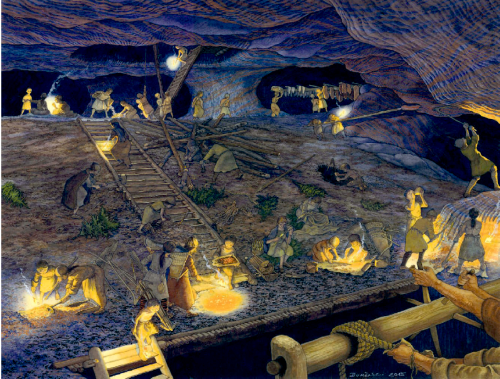The Ancient Practice of Child Labor Is Coming to Light
Researchers piece together the stories of the smallest ancient laborers.
By Bridget AlexMay 22, 2020 12:00 PM

This artist’s rendering shows a snapshot of what life may have been like in
the Hallstatt salt mine during the Bronze Age.
(Credit: D. Gröbner & H. Reschreiter/NHM Vienna)
The tattered leather slipper would have fit a child under the age of 10. Well preserved for footwear nearly 3,000 years old, it was discovered decades ago in the Hallstatt salt mine. Together with other small shoes and woolen and leather caps, also found deep beneath the Austrian Alps in the mine’s tunnels, the slipper would provide archaeologists with a key clue to life in Hallstatt during the Bronze and Iron ages, 2,600 to 3,000 years ago.
“We must conclude … children were regularly and in large numbers employed for underground mining,” wrote Fritz Eckart Barth, the archaeological site’s director in 1992, when the slipper was analyzed.

Hallstatt, Austria. (Creidt: Rastislav Sedlak SK/Shutterstock)
In the years since the shoes and caps spurred investigations at Hallstatt,
scientists have assembled a vivid picture of the child laborers’ lives based
on artifacts and bones. Wear and tear on their skeletons, in particular,
suggests the youngest miners performed specific tasks at the site.
The research stands out as a rare case of reconstructing the lives of ancient children. Although scientists have found fossils of juveniles spanning prehistory, they’ve mostly studied physical traits, like height and brain size. Few studies have re-created everyday experiences — how kids played, learned and labored.
More:
https://www.discovermagazine.com/planet-earth/the-ancient-practice-of-child-labor-is-coming-to-light?utm_source=feedburner&utm_medium=feed&utm_campaign=Feed%3A+DiscoverLivingWorld+%28Discover+Living+World%29

